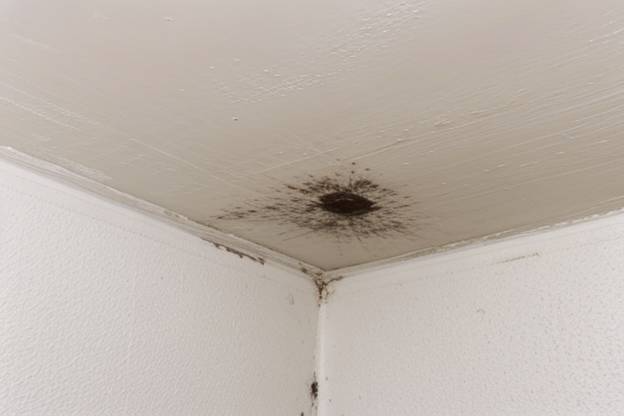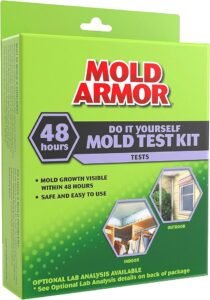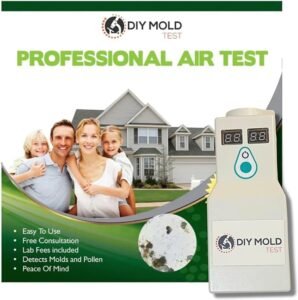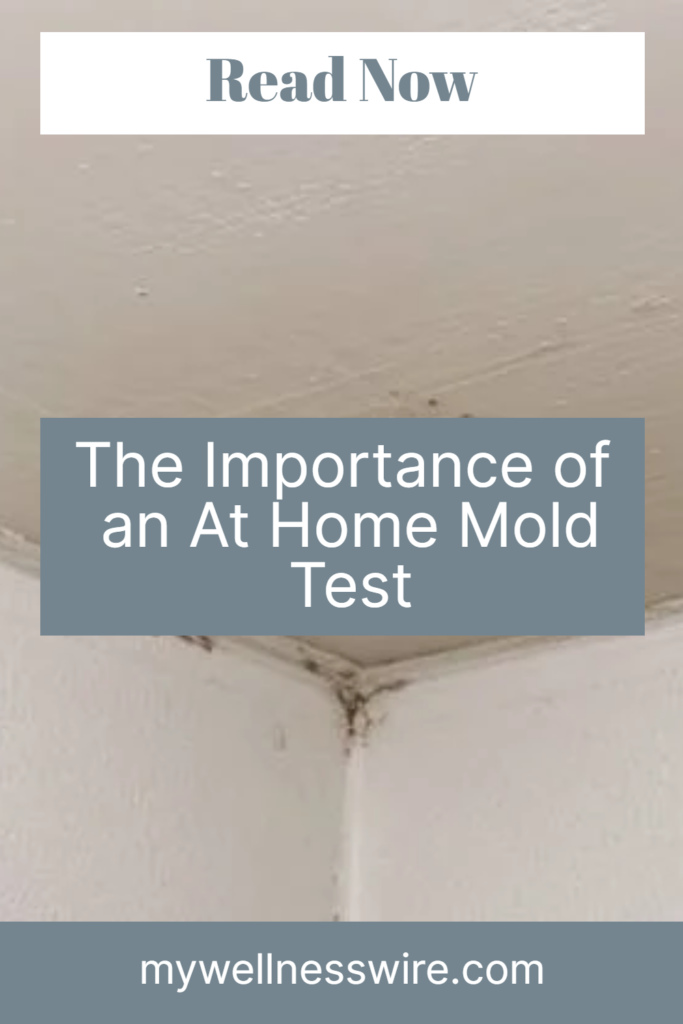
Intro
Are you concerned about potential mold growth in your home? Have you noticed musty odors or unexplained health symptoms? If so, conducting an at home mold test may be the solution you need.
In this blog post, we will explore the importance of using an at home mold test to detect and address mold issues in your living space.
Understanding Mold and Its Impact on Health
Mold, a ubiquitous fungus found in many environments, can become a significant health concern when it establishes itself indoors. Favoring moist, shadowed areas, it proliferates on common household materials, releasing spores that contaminate the air.
The inhalation of these spores is primarily responsible for the array of health issues associated with mold exposure.
Symptoms can range from the relatively mild. These include sneezing, sore throat, and skin rash, to more severe reactions, including persistent headaches, dizziness, and fatigue.
Those with allergies or asthma may experience exacerbated symptoms, highlighting the need for prompt attention to indoor mold growth.
Mold exposure is not just a surface-level irritant; it can lead to more profound respiratory concerns. Individuals with compromised immune systems or chronic lung diseases are at a heightened risk, potentially facing serious infections.
The presence of certain toxic molds, like black mold (Stachybotrys chartarum), which produces mycotoxins, can pose severe health risks, underlining the importance of early detection and management.
Recognizing these risks is the first step toward maintaining a healthier indoor environment. And underscores the value of employing an at-home mold test to safeguard against the dangers mold poses to our well-being.
The Advantages of Conducting an At Home Mold Test

Using an at home mold test presents a multitude of benefits for homeowners keen on maintaining a healthy living environment.
The foremost advantage is its immediacy and accessibility; you can initiate the test at your convenience without the need to schedule a professional inspection, which might not be immediately available.
This self-administered approach empowers homeowners to take swift action in identifying potential mold issues before they escalate into more serious problems.
Cost efficiency is another significant benefit. Professional mold inspections can be expensive, especially if they necessitate multiple visits or involve extensive testing throughout a large property.
At home mold tests, in contrast, offer a cost-effective alternative, providing substantial savings without compromising the ability to detect mold presence. This makes mold testing accessible to a broader audience, ensuring more households can address mold concerns proactively.
Additionally, these tests serve as a preliminary screening tool, helping to pinpoint specific areas of concern within the home. This targeted approach can be particularly useful in large homes or properties with multiple potential sources of moisture and mold growth.
By identifying problem areas, homeowners can prioritize remediation efforts. As a result the process is efficient and potentially reduces the cost of professional mold removal services should they be necessary.
Continuous vigilance is key in preventing the recurrence of mold, ensuring a safer and healthier living environment for all occupants.
How At Home Mold Tests Work
Initiating an at home mold test is a straightforward process facilitated by the use of a comprehensive kit, which is readily available for purchase online or at local hardware stores.
These kits are designed to enable homeowners to easily collect samples from their environment without the need for specialized knowledge or equipment.
The typical kit includes various collection tools, such as petri dishes for settling tests, swabs for surface sampling, and sometimes air pumps for air quality tests.
The method of collection will depend on the suspected source and type of mold. For instance, surface sampling with swabs might be ideal for visible mold on walls. While air samples might be necessary for a more generalized concern about air quality and invisible mold spores.
Once the sample collection is completed, the next step involves sending these samples to a designated laboratory, which is usually specified in the kit’s instructions. This lab will then perform a detailed analysis to identify the types and concentrations of mold present in the samples. This analysis is crucial as it determines not just the presence of mold but the specific varieties. Some of which may pose more health risks than others.
It’s essential to meticulously follow the kit’s instructions for sample collection and submission to ensure the accuracy of the test results.
Missteps in the collection process can lead to contaminated samples or false readings. Which in turn could either falsely reassure homeowners or cause unnecessary alarm. Proper execution of these tests is the linchpin in obtaining reliable data on which to base any further mold remediation actions.
Choosing the Right Mold Test for Your Home
Navigating the plethora of at home mold test options requires a thoughtful approach to ensure that your specific needs are met. When embarking on this selection process, start by assessing the variety of molds you suspect might be lurking in your home.
Given that different kits are optimized for detecting either a broad spectrum of molds or targeting specific strains, understanding the nature of your concern is crucial. For households with a history of water damage or visible mold patches, a test that offers comprehensive analysis might be the most prudent choice.
Conversely, if you’re investigating a particular area or type of mold, a specialized kit could provide the focused insights you need.
Another factor to weigh is the scope of the area you intend to test. Kits vary in the volume of space they can effectively assess, so it’s vital to match the kit’s capabilities with the size of your home and the number of rooms you’re concerned about.
Test Methodology
Additionally, consider the methodology of the mold test. Some kits use petri dishes to capture spores over a period, while others rely on swabs or air samples for immediate collection.
Each method serves different purposes, with air samples being crucial for evaluating overall air quality and petri dishes or swabs being more suited for pinpointing specific mold growth on surfaces.

Lastly, the clarity and detail provided in the test’s reporting should influence your choice.
Opt for a mold test that delivers easily interpretable results, detailing not only the presence of mold but also the concentration and variety.
This information is instrumental in guiding your next steps, whether it’s remediation efforts or further professional evaluation. By considering these factors, you can select an at home mold test that aligns with your household’s unique circumstances, paving the way for effective mold management and peace of mind.
Interpreting the Results of Your Mold Test
Upon receiving your at-home mold test results, deciphering them accurately is paramount. A positive identification of mold spores indicates the necessity for immediate and appropriate action.
The specific types and concentrations of mold identified in the test results will guide your next steps. For minor mold issues, this might involve a thorough cleaning with mold-killing solutions and addressing any moisture sources that contributed to the mold’s growth.
In cases where toxic molds or high concentrations are detected, it may be imperative to engage professional mold remediation services to ensure a comprehensive and safe removal process.
Understanding the types of mold present is crucial, as some species are more harmful than others and may require different handling strategies.
The results should also prompt a review of your home’s ventilation and humidity control systems to prevent future mold occurrences. Remedial actions should be followed by a re-test to verify that mold levels have been effectively reduced and are within a safe range.
This proactive approach, based on the interpretation of your test results, is essential in maintaining a healthy living environment and preventing the long-term consequences of mold exposure.
Preventing Mold Growth in Your Home
To stave off the proliferation of mold within your dwelling, there are practical measures you can employ. A pivotal step is to maintain indoor humidity at a manageable level, ideally between 30% and 50%, through the use of dehumidifiers or air conditioners.
Swiftly addressing any instances of water damage—be it from leaks, flooding, or condensation—is critical to denying mold the moist environment it thrives in.
Ensuring that your home is well-ventilated, particularly in areas prone to dampness such as the kitchen, bathroom, and laundry room, can significantly deter mold growth. This might involve installing exhaust fans or cracking open a window to improve airflow.
Regular cleaning routines play a crucial role in mold prevention, especially in spaces where mold is likely to establish a foothold.

Utilizing mold-resistant products in these high-risk areas can provide an additional layer of protection.
For instance, opting for mold-resistant paint or installing tiles instead of carpeting in basements and bathrooms can make a difference.
It’s also beneficial to inspect your home regularly for signs of mold, focusing on hidden areas like under sinks, in closets, and around window sills.
By implementing these proactive measures, you can create an inhospitable environment for mold, safeguarding your home’s structural integrity and the health of its occupants.
FAQs
Q: What are some common areas in a home where mold growth may occur?
A: Mold growth commonly occurs in areas that are consistently damp and humid. This includes bathrooms, kitchens, basements, attics, laundry rooms, and near leaks in roofs or pipes.
Q: Will an at-home mold test tell me where exactly the mold is located in my home?
A: An at-home mold test can identify the presence of mold spores in your indoor air, but it won’t specify the exact location of the mold. For a comprehensive inspection and precise location detection, you may need to hire a professional mold inspector.
Q: Are all types of mold dangerous, or just certain strains?
A: Not all molds are harmful, but several strains, like Stachybotrys chartarum (also known as black mold), can pose health risks. Symptoms from exposure may vary from minor irritations to more serious respiratory problems, depending on the individual’s sensitivity and the duration of exposure.
Pin this post to read later



